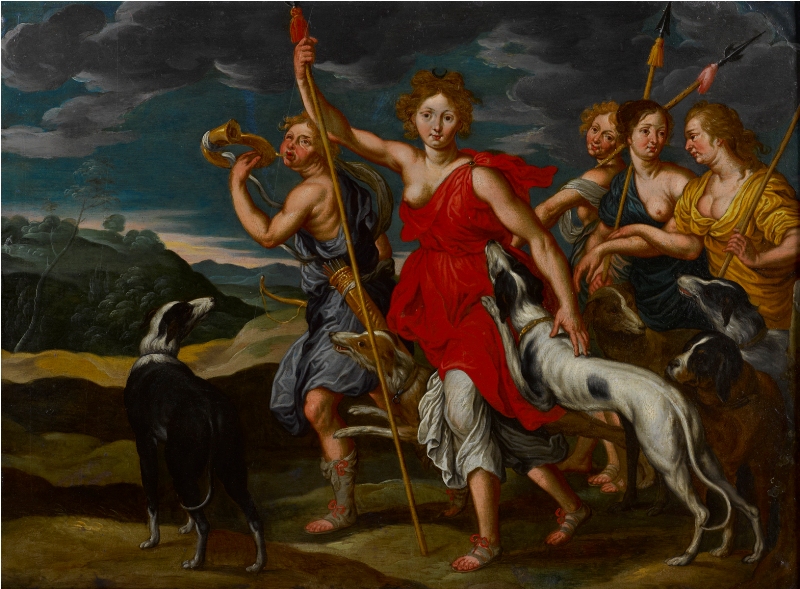- View Catalogue
- Lot 270
Studio of Peter Paul Rubens
Diana and Her Nymphs on the Huntoil on copper
This is a fine work after Peter Paul Rubens’ Diana as Huntress, now in the Museo del Prado, Madrid. Prado no. 1727. Original size 182 x 194. Illus. in colour Matías
díaz Padrón, El Siglo de Robens en el Museo del Prado. Catalogo Razonado de Pintura Flamenca del Siglo XVII, Vol. II, Museo del Prado, p.1023.
• Another version of this painting is in the Palazzo Montecitorio, Rome.
The subject
Rubens was famous for his dynamic scenes of the chase or hunt that were sought after by European monarchs; Philip IV of Spain owned about ten. Rubens aimed to
revive the tradition of the scene of the courtly hunt and also painted smaller ‘cabinetpictures’ or scenes of the huntress Diana for Archduke Albert.
The subject derives from the classical world and is found in Ruben’s oeuvre in various guises, including the versions of a more scantily clad Diana in the J. Paul
Getty Museum and the Museum of Art, Cleveland. There are differences in the Shapiro copy from the Prado original that seem quite
deliberate. The colouring is of a higher key and the draperies are more billowing. The trumpet-blower’s tunic has been changed from a grey to blue that gives him
more prominence and changes the effect of the composition. The sky is less sketchy and the clouds are more ominous. The faces of Diana and her nymphs are less
classical and have become more detailed and Northern European in manner. The painting is somewhat longer than the surviving original and therefore the landscape
is given more space. Objects such as the spears are more carefully delineated which gives an effect of verism. The landscape is quite different and more Netherlandish in
feeling. In conclusion, one might surmise that the Rubens Prado original is a more cosmopolitan work, which was characteristic of his painting practice.
The version presented here might have been designed to satisfy a particular local taste, which appears to be more a Franco-Flemish one.
Diana is the star of both paintings, her beautiful red tunic contrasting with the exciting glance of part of one breast and bare shoulder, and a rhythmic triangle
running up towards the viewer’s left, one of a series of geometric shapes that create the dynamism of this scene. Rubens may have derived the composition from a
classical frieze. He copied in chalk such a frieze after Michelangelo’s The Battle of Lapiths and Centaurs 1600-03, which was clearly based on a Roman sarcophagus
(stone coffin). Here the hounds take the place of writhing bodies and the upheld arms of Diana and her trumpeter replace those of centaurs.
Diana as Huntress originally was part of a group of Flemish paintings in King Philip IV of Spain’s palace in Madrid. It was part of the decoration of his new
summer apartments that were readied soon after his accession in 1621. The work was placed in the largest room in his private spaces, a ‘supper room’ that was
adjacent to his bed-chamber. Two works by Rubens, the Diana as Huntress now in the Prado of which we see a copy here, and Ceres and Pan hung there, along
with other voluptuous Flemish work such as Jan Brueghel’s Wedding Banquet and two Allegories of the Five Senses, works by Frans Snyders, and works of fruits and
flowers. This was an array of contemporary art by Antwerp artists and representedthe height of fashion in the early seventeenth century.
Rubens himself visited these apartments in 1628-9 when he worked for Philip IV and copied the famous Titians in his collections. Rubens’ earlier hunt scenes
revolved around the extraordinary animals they depicted; around 1620 he became more interested in the theme of Diana and her mythological narrative. Deer hunting
appears rather than other wild beasts and ‘comely females are displayed in action in later hunting scenes also’ (Balis, 31). A part of the appeal of the scene of Diana as
Huntress was its relatively small size vis a vis the very large canvases that Rubens often painted of wolves, tigers and other beasts; the small size might have conferred
an erotic prestige that would not have been lost on the viewers. As the Rubens scholar Balis wrote in 1968: ‘with remarkable virtuosity he succeeded repeatedly
in devising compositions that were more compelling in their representation of movement as such than for their dramatic content’ (Balis, 35).
Bibliography
Arnout Balis, Rubens Hunting Scenes. Vol. of Ludwig Burchard and others: Corpus Rubenianum Ludwig Burchard. An Illustrated Catalogue Raisonné of the Works of
Peter Paul Rubens based on the materials assembled by the late Dr Ludwig Burchard in Twenty-six parts, trans. P.S. Falla, Harvey Miller Publishers/Oxford University
Press, 1968
Matías díaz Padrón, El Siglo de Robens en el Museo del Prado. Catalogo Razonado de Pintura Flamenca del Siglo XVII, Vol. II, Museo del Prado,
Mary Crawford Volk, ‘Rubens in Madrid and the Decoration of the King’s Summer Apartments’, The Burlington Magazine, 123: 942, September 1981, 513-529
- Measurements:
- 24.5 x 32 cm
- Provenance:
- Letter of Authenticity certified by Galery D'Art Sepia, France, The Barbara Sheridan Donnay and the Late Gilbert J. Donnay Collection
- EStimate $25,000 - $35,000

